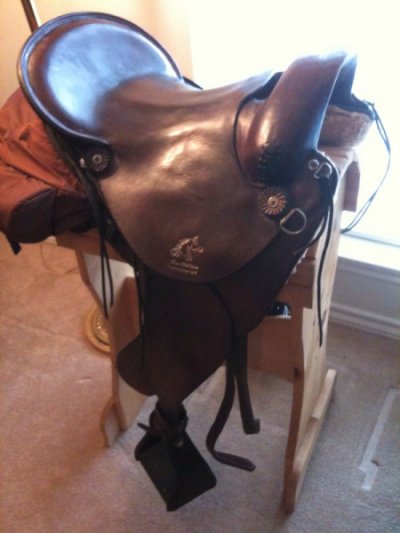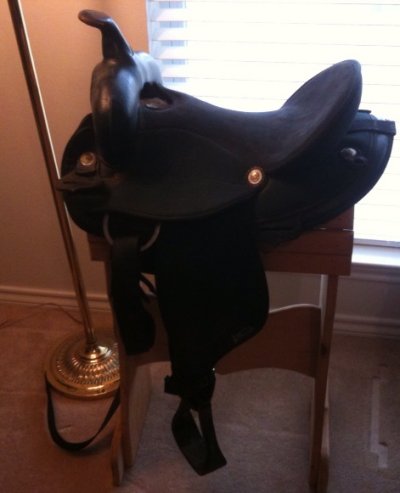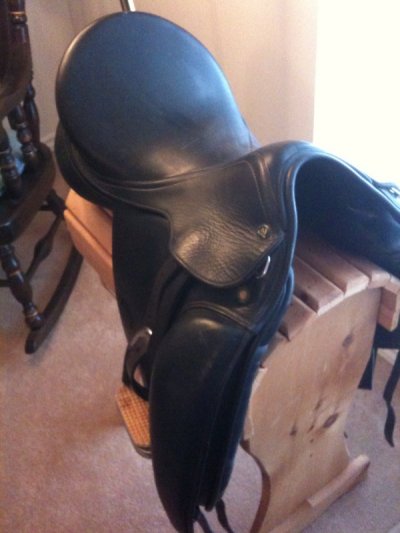By Chris, Five Star Ranch Staff Writer

For centuries, leather was the traditional go to material used to make saddles. You bought a leather saddle and it lasted a lifetime.
Now it is not uncommon for people to have several saddles for the different riding disciplines they might enjoy.
I personally own many saddles, some western saddles, endurance saddles, multiple dressage saddles, and a variety of English jumping and general purpose saddles in a mix of leather and synthetics. My family has six horses and each one has a different build so I can’t share saddles between my horses.
Since I have both leather and synthetic saddles, I am frequently asked which material is better. I hate to be wishy-washy, but the answer is: Which is best depends. The final answer may be to own both.
I’ve tried to capture my thoughts on both by listing several criteria and describing how each fares. It may be that you too may end up with a mix of both leather and synthetic.
Synthetic Saddles: Pros and Cons
Weight of Saddle
No doubt about it, synthetic variations of a saddle are lighter than their leather counterparts. This makes a synthetic saddle easier for a child or woman to lift a saddle onto a horse. After I broke my hand last Spring, I was glad I had lightweight non leather saddles I could easily lift onto my tall horse’s back.
A lightweight leather trail saddle weighs close to 30 pounds and a roping saddle with a reinforced horn might way around 50 to 60 pounds. That is a lot of saddle to hoist on a horse’s back. My synthetic endurance saddle weighs with girth weighs around 15 pounds. It is much easier for me to lift.
Another consideration is that synthetic saddles are less weight for the horse to carry. If you’re heavy and concerned about the weight your horse is carrying, a synthetic saddle might lighten the load.
Care and Cleaning or How do I Clean a Synthetic Saddle?
The good news is synthetic saddles are easy to clean. You can wipe off scuff marks and for cleaning after especially muddy rides, I’ve literally hosed my synthetic saddle down with a garden hose. Getting wet doesn’t hurt them – which also makes them ideal if you decide to go swimming with your horse.
To clean my leather saddles I use a sponge and glycerin soap (which is great for your hands). I also oil them several times a year.
Lifespan

Okay, leather saddles have a longer lifespan, so leather wins this criterion. That said, there is no reason your synthetic saddle should live at least ten years, many longer with normal wear and care.
The first synthetic I bought around 1999 barely looks worn today. I guess they are like most things, if they are cared for you can stretch out the life span.
When my daughter was little I didn’t want to invest in an expensive leather saddle she would outgrow in a few years, so I bought her a child’s sized synthetic saddle. Delaying an expensive purchase until you know riding isn’t a passing whim could save you an unnecessary expense. The lighter weight made it easy for her to saddle her own horse which gave her a sense of accomplishment and independence.
Fitting
If you have different horses and they are of different builds, you often have to have different saddles for them as not every saddle fits every horse. I know many people who had to sell their fancy imported saddle because it didn’t fit their new show horse. If you have multiple horses, getting them the cheaper synthetic saddles has its advantages. You can afford to get a saddle that fits the horse, rather than try to make the saddle fit by using special pads which usually makes the fit problem worse.
Several synthetic saddle manufacturers provide the ability to change out the gullets so you can actually customize the fit of the saddle for the horse. This allows you more flexibility in fitting the same saddle to different horses. There are a few leather saddle makers who make adjustable trees in their leather saddles. However, more synthetic manufacturers than leather offer changeable gullets.
One synthetic manufacturer even offers air panels that cushion the horses back. I would definitely test those out on the horse before purchasing. Some horses love the air cushions and other revolt in the way of a kicking spree. I would caution against the air cushion if you ride at altitude as the cushion can feel like a hard rock in higher altitudes.
Another option for someone with a really hard to fit horse might be a treeless saddle. These don’t press on your horses back like a regular saddle, but most people recommend you already have a secure seat before you transition to a treeless. Treeless manufacturers are pretty forthcoming that they are not for everyone. The general guidance is if you are heavy (say over 250 pounds), you might want to consider a regular saddle with a tree to lift you off the horses back.
Looks

Bright colors – Leather saddles come in tan, brown or black. The only color is usually in the seat. That said, I’ve seen some fancy custom dressage saddles with patent leather and tons of bling.
Synthetic saddles come in every color imaginable. You’re limited only on your tolerance to gaudiness.
I tend to be conservative in my choice of synthetics and normally stick brown and black although I do have one green one. However, my Kids love the colors and I know several little girls who are very proud of their pink saddles.
Many of the synthetics have a version that look like leather. You have to do a double take on them because they could easily pass as leather. These tend to be higher end synthetics, but if you don’t want a saddle that screams synthetic, they are a good choice.
Cost
Synthetic saddles are less expensive. Leather saddles last longer, but the initial investment is more than synthetics. If you want leather tack, one alternative to blowing your budget is to buy it used. Since well cared for leather tack will last for years, you can often find great brand names in the used tack market.
Versatility – Types of Saddles
Leather and synthetic saddles come in all varieties for all riding disciplines. The one advantage of a synthetic in versatility is that you could inexpensively test out a riding style in a synthetic saddle before you invest on an expensive leather version.
I have a wonderful synthetic dressage saddle that I found used that was a fraction of a leather saddle…it was my first venture into dressage. I wasn’t sure I would like dressage and didn’t want to waste money until I had given it a chance. I got hooked and now in addition to my little synthetic, I have three leather dressage saddles for show. Did I mention no two of my horses can share a saddle?
Show Ring
Since I ride different disciplines, I have synthetics for day to day riding, and save my leather saddles for shows. Many judges are traditional and are partial to leather, so if you can afford it, use leather in the show ring. Synthetics are fine for play day shows and gymkhanas, but for A-level shows, I’d recommend you bring out your leather.
Okay, hopefully I’ve shed some light on pros and cons of synthetic and leather tack. Both are great and depending on your goals one or both might work for you.